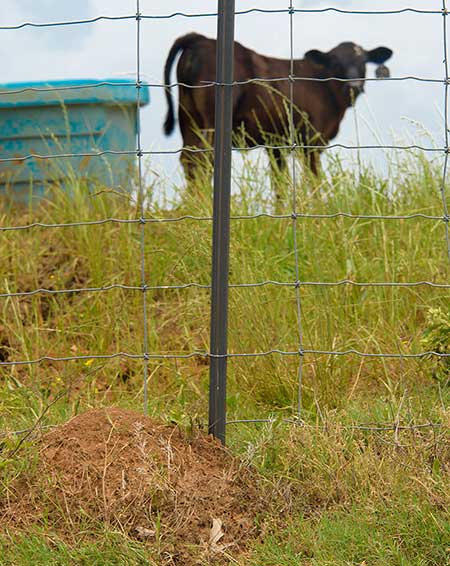News
The information presented on this page may be outdated. It may refer to situations which have changed or people who are no longer affiliated with the university. It is archived as part of Mississippi State University's history.
Hay, forage producers wage war on fire ants

Southern farmers may never win the battle against imported fire ants, but aggressive tactics can slow the pests? invasion, reduce damage and prevent further spread across the United States. (Photo By: Kevin Hudson)
5/19/2015
By: Linda M. Breazeale
Jane Parish is an Extension/research professor with the Mississippi State University Extension Service and the Mississippi Agricultural and Forestry Experiment Station. She said cattle and hay producers have learned to live with and work around the troublesome ants since the pests arrived in the state almost a century ago.
"Fire ants are a painful aggravation. No one can do farm work without getting stung from time to time," Parish said. "Their mounds can damage cutting equipment, and if a calf is born too close to a bed, the results can be catastrophic, especially for weaker calves that may already have health issues."
Parish said producers may believe effective control costs are too high on larger farms like the Prairie Research Unit that she manages in Monroe County, but spot treatments in certain areas can be helpful.
"If only treating part of the farm, calving pastures should be a first priority to help protect cows lying down to calve and their newborns from being born into a heavily infested area," she said. "Hospital pens and receiving pens on stocker operations would be examples of other high-priority areas to treat."
Native to South America, imported fire ants first entered the U.S. around 1918 at the Port of Mobile and made their way into Mississippi in the 1930s. They have since spread to every county in the state and throughout most of the Southeast.
Rocky Lemus, an associate Extension/research professor, specializes in grazing and forage systems. For most Mississippi hay producers, forage is grown in spite of fire ants. The pests can be more trouble in square-bale fields when hay is hauled by hand.
"Monitor for fire ant activity in and around hayfields. When the numbers are high, treat with broadcast baits according to label directions," Lemus said. "Take care to avoid getting treatments on hay bales."
Lemus said commercial hay producers must be aware of fire ant quarantine lines to reduce their spread across the country.
"Fire ants have moved across the South and into isolated areas of California and New Mexico," he said. "Quarantines control the movement of some products, like soil, plants and hay, to help stop the spread of these invasive pests."
Producers can ship hay from inside the quarantined area to other locations inside that quarantined area. Hay destined for locations outside the quarantined area must be certified as fire-ant free by the Mississippi Bureau of Plant Industry before it can be shipped.
Lemus said most of the requirements for certification refer to storage conditions, not growing conditions.
"Baled hay that is stored in direct contact with the ground will not qualify for certification and cannot be moved outside the quarantined area," Lemus said. "Trucks and trailers will also need to be cleaned of any soil before loading."
"Before hay is approved for shipping outside the area, an inspector from the Bureau of Plant Industry will place an attractant on the hay to determine if fire ants are present," Lemus said. "If clear and all other standards have been met, a certificate will be issued to accompany each load to the destination and provided to the recipient."
Extension entomologist Blake Layton said fire ants can be controlled in pastures and hayfields with granular baits, ideally before major infestations occur.
"Baits work slowly, so they need to be applied as preventatives or deterrents," he said. "One annual treatment—ranging from $8 to $15 per acre—will reduce populations, but to eliminate or prevent mounds around a barn or paddocks, more than once a year will be necessary."
Layton said to read and follow label directions closely.
"Not all fire ant baits are labeled for hayfields and pastures," he said. "The three active ingredients currently labeled for use in forages are methoprene, pyriproxyfen and hydramethylnon."
He warned that dry mound treatments containing the active ingredient acephate, common in home lawn treatments, leaves illegal residues that are dangerous to livestock.
"Only purchase enough fire ant bait for one season because the oil in the baits will go rancid and no longer attract ants," he said.
For more information on controlling fire ants in pastures, hayfields and barnyards, go online to msucares.com/pubs/publications/p2493.pdf.
View More News